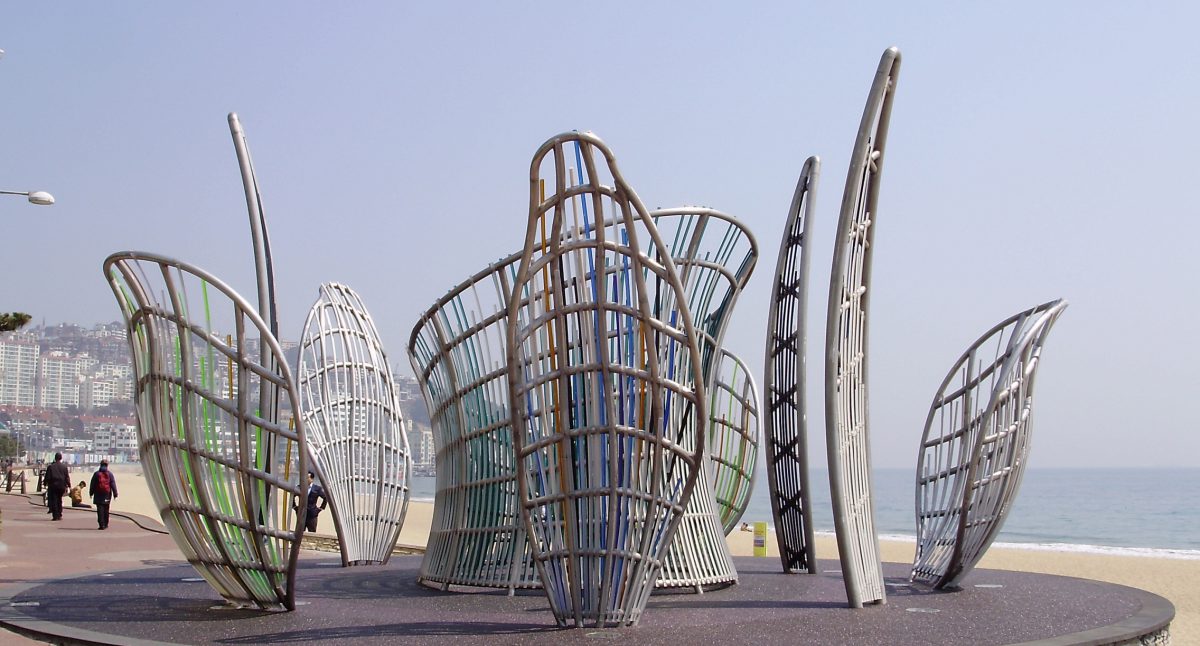A sculpture by the late US artist Dennis Oppenheim has been destroyed in South Korea by the Haeundae District Office, local authorities. They said the beach side installation had fallen into disrepair and was becoming an “eyesore”. “Chamber”, was installed next to the beach at Haeundae as part of the Busan Biennale in 2010.
“I have never been able to be what they call a signature artist” – Dennis Oppenheim
The Dennis Oppenheim work fashioned in steel and plastic depicts a flower with open petals. The work was more than eight metres wide and six metres high, and cost 800 million won ($750,000). The tourist attraction was constructed so visitors could walk between the “petals” and take pictures, the organisers of the Busan Biennale described it as a work that requires the viewer to enter it and walk amongst it’s many varied walls. The forms making up the components were generated from the petals of flowers. “It is not a particular flower but a composition of many different varieties that forms”, the original brief stated.. The curved and organic forms rise to as much as four meters, creating a particular sensory experience for the viewer. The wall forms are not flat like most architecture. They are largely concave allowing the viewer’s body to imagine flowing into them, they are gentle, wave like configurations. But in journeying through to the middle you realize that you’re being restricted, the walls are closing in.
The Busan Biennale 2010 proposed the Dennis Oppenheim sculpture as part of a theme of ‘Living in Evolution’ and exhibited Sep. 11 to Nov. 20, 2010 at Busan Museum of Art, Busan Yachting Center and Gwangalli Beach. It was designed to identify relations between man’s finite life and their creation, such as history and civilization, and to discover insights on relations between arts and society, the present and the future, and me and the world. Viewers had come to look back upon their daily life while enjoying artworks. Also they experienced ‘evolution’ of individuals and mankind.
Dennis Oppenheim the pioneering conceptual artist died of complications from liver cancer, he was 72. Oppenheim was born in 1938 in Electric City, Washington and studied at the California College of the Arts and Stanford University, before moving to New York in 1966. He made a name for himself as one of the first land artists in the 1960s, and explored Body Art at the inception of the movement. Oppenheim’s work evolved into the first wave of Conceptual Art and was influential and embraced by a younger generation of artists. He was a contemporary of ground breaking artists including, Vito Acconci, Gordon Matta Clarke and Bruce Nauman. His work has been exhibited in galleries and museums internationally, including Tate Modern, London; the Museum of Modern Art, New York; the Stedelijk Museum, Amsterdam; and the Whitney Museum of American Art, New York. He stated,”The age of experimentation in art has ended, but if it has, it’s also created an opening for a new camaraderie of artists working in architecture and public space, making work with people in mind. Functionality and design once problematic for fine artists are now where exciting things are happening. It’s a natural progression, but there’s still some resistance. I have fond memories of operating in a studio as a pure scientist, with absolutely no agenda other than to brainstorm art theory and develop new methods. I miss that. My public art does demand similar responses on my behalf to make it successful, but not at the level of penetration that studio work offers: what art can, should, and can’t be—all these heavy questions”.
“I have never been able to be what they call a signature artist,” he said in one of his final interviews, “Most of my work comes from ideas. I can usually do only a few versions of each idea. Land Art and Body Art were particularly strong concepts, which allowed for a lot of permutations. But nevertheless, I found myself wanting to move onward into something else.”
“We’ve sent the wreckage, mainly steel pipes and polycarbonate materials, to a waste dump”, Shi added, denying local news reports that the metal was sold for scrap. A spokesperson admitted, that the district office had failed to tell Oppenheim’s estate – which holds the intellectual property rights to the work – of its removal.
Representatives of the Busan Biennale were outraged.

